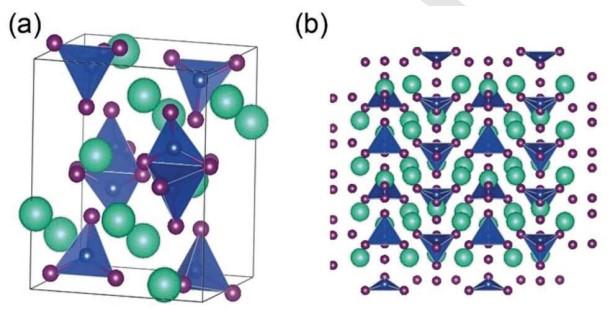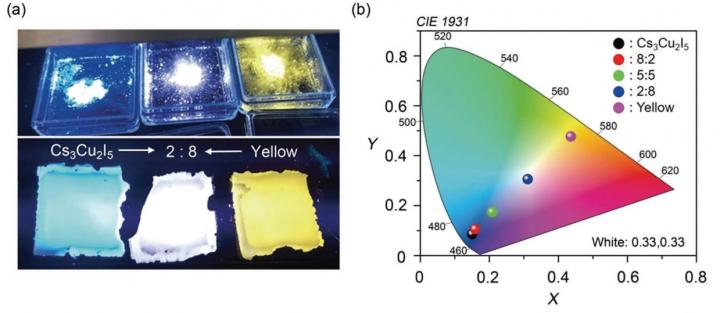
New Blue-Emitting Material Is Lead-Free, Highly Efficient
TOKYO, Sept. 21, 2018 — A novel photoluminescent, lead-free, zero-dimensional (0D) material, designed by scientists at Tokyo Institute of Technology, could be used to fabricate thin films for quantum dots (QDs) and other nanotechnologies.

This is the crystalline structure of the proposed material. The green dots represent cesium atoms, and the blue bodies correspond to the (Cu2I5)3 units that are confined between them. The cesium atoms plus the (Cu2I5)3 units can be regarded as core-shell structures, which enhance the photoluminescent properties of the material. Courtesy of Advanced Materials.
The fabricated material, Cs3Cu2I5, has a crystalline structure. The cesium atoms confine the (Cu2I5)3 units, which emit blue light when excited at specific frequencies similar to QDs. The researchers fabricated a thin film using their new material, which proved to be highly stable and to have excellent photoluminescent characteristics. Cs3Cu2I5 was found to exhibit blue emission (~445 nm) with very high PLQYs of ~90 and ~60 percent for single crystals and thin films, respectively.
“The thin film exhibited good stability under ambient conditions, that is, no noticeable degradation in photoluminescent quantum yield (PLQY) over two months,” said professor Hideo Hosono.

By mixing the proposed material with a yellow phosphor, a white photoluminescent film was made, demonstrating one of the potential applications of this novel material (a). The color of the produced photoluminescent film can be changed by adjusting the ratio of the proposed material to the yellow phosphor used (b). Courtesy of Advanced Materials.
The team demonstrated two applications using this material. The first was a white luminescent film, fabricated by mixing the blue-emitting material with a yellow phosphor at a specific ratio to produce white light. According to the researchers, films that emit light of various colors could be prepared by varying the ratio of the ingredients used.
The second application was a blue LED, which exhibited poor electroluminescence (EL) performance. However, the experiment and its results helped the team to better understand the mechanisms underlying EL, which could be useful in future research.
“The exploration of low-dimensional compounds based on a Cu(I) halide proved to be a novel route to obtain a Pb-free high-PLQY luminescent material,” said Hosono.
Halide perovskites, including CsPbX3, have gained attention in the field of optoelectronics. However, the toxicity of Pb (a semi-crystalline polymer) and the low PLQY of these perovskites can hamper their use.
The new material, which meets the requirements of nontoxicity, high PLQY, ease of fabrication, and low cost, could be used in future optical and nanotechnological applications, and could enhance understanding of the nature of photoluminescent materials.
The research was published in Advanced Materials (doi: 10.1002/adma.201804547).
Published: September 2018